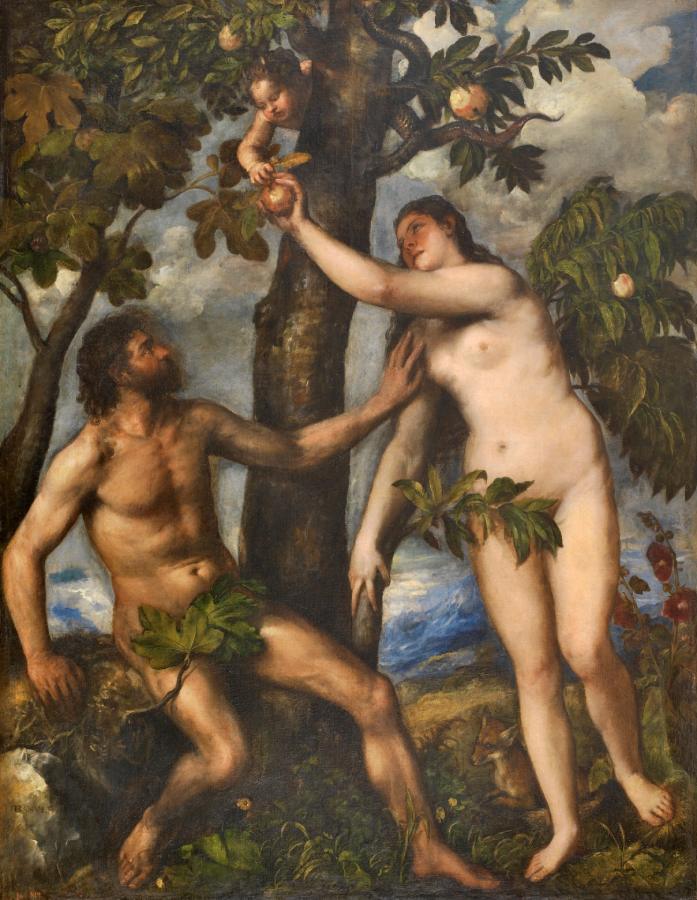Tiziano (c.1488-1576)
Adamo ed Eva (Adam and Eve)
c.1550
Oil on canvas, 240 x 186 cm
Museo del Prado, Madrid
The painting is a faithful visualisation of Genesis 30, 9-19 in which Eve is blamed for accepting the forbidden fruit (although the type of fruit is not stated, Titian follows tradition and opts for an apple) and there is a reference to a second tree, a fig, whose leaves are used by Adam and Eve to cover their nakedness. Although we do not have a definite date for this painting, nor do we know the name of its original owner, it is generally identified as the ‘quadro grande de Adán y Eva de mano de Ticiano’ inventoried on 21 May 1585 as being among the possessions of Antonio Pérez. With regard to its dating, we know that from 1530 onwards Titian painted for Gonzalo Pérez, the father of Antonio, and that the former was still receiving works by Titian in 1573. Scholars have usually dated this painting to the 1550s, which seems compatible with the manner of modelling the forms, which are still defined, and the use of the Dying Gaul sculpture for the figure of Adam, as this was the period when that sculpture most influenced Titian, as many observed in the lost Tantalus or the Moses in The Glory. Other sources have been cited, such as the fresco by Raphael of the same subject in the Stanza della Signatura, from which Titian derived the idea of combining the seated Adam and standing Eve, and the figure of Dyrse in the Farnese Bull sculptural group from which he took the pose of Eve accepting the fruit. In addition, there is Dürer‘s print of Adam and Eve of 1504, which has also been mentioned in relation to Eve and in the emphasis on the iconographic elements, although Titian limits them to the fox, traditionally associated with the devil, and the child-serpent who offers the apple. Other aspects of the painting recall earlier works by the artist, such as the device of darkening one of the protagonists’ faces, in this case that of Eve, to create a more dramatic effect, used by Titian since the Padua frescos of 1511, and found, for example, in the Hampton Court Lucretia. The X-radiograph reveals significant changes. Adam appears as more up-right, with his torso more twisted to one side, his right leg closer to the left and his right arm more angled. Eve is also slightly turned, more evident in the face and hip, while her arm nearer the spectator was originally lower. The change in the arm was the result of including the child-serpent, as initially Eve took the apple herself from a lower branch, but Titian decided to show that the action was the result of temptation and not Eve’s own initiative, including the serpent slightly higher up. The change of pose and position of the arm was, however, not well resolved. Probably in order not to obscure the apple (whose consumption triggers the dramatic events that follow) from the spectator’s view, Eve makes an unnatural movement and turns her hand to take the fruit from behind, but this movement is not matched by a corresponding turn of her forearm. For the child-serpent’s forked tale, Titian reused what had formerly been two branches in his original composition. The painting produces contradictory sensations. The brilliant colouring, particularly in the landscape, contrasts with a certain clumsiness in the treatment of the figures, particularly Eve’s gesture mentioned above and Adam’s wiry anatomy, whose excessive fidelity to its sculptural model meant that fig leaves had to be added to cover his genitals, spoiling the overall effect of the figure. Aware of these weaknesses, in his Adam and Eve after Titian (P1692), Rubens altered the pose and showed Adam turned more to the side in a pose closer to that seen in the X-radiograph of the present work. Thanks to this and to other less significant changes, Adam and Eve is the only one of Rubens‘ numerous copies after Titian which is actually better than the original. Like other paintings belonging to Antonio Pérez, in 1585 Titian‘s Adam and Eve passed into the possession of Philip II, on whose death it was hanging in the Sacristy in the Alcázar in Madrid, remaining in that building until the fire of 1734 and copied there by Rubens during his second stay in Spain from 1628 to 1629. Just before 1636 it was moved from a sacred location (the Sacristy) to a secular one: the so-called vaults of Titian which housed the finest nudes in the royal collection, remaining there until 1734. It was inventoried in the Buen Retiro Palace in 1746 and later in the Palacio Real Nuevo before entering the Museo del Prado in 1827. (Falomir Faus, Miguel, Tiziano, Madrid, Museo Nacional del Prado, 2003, p.252)
